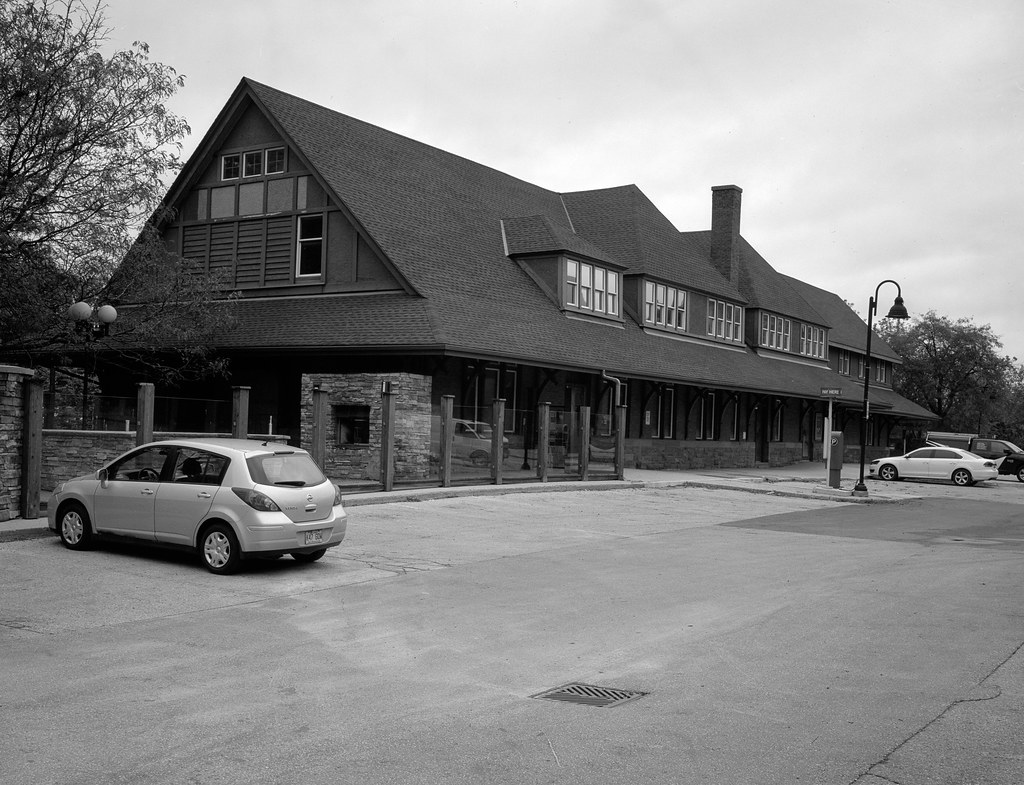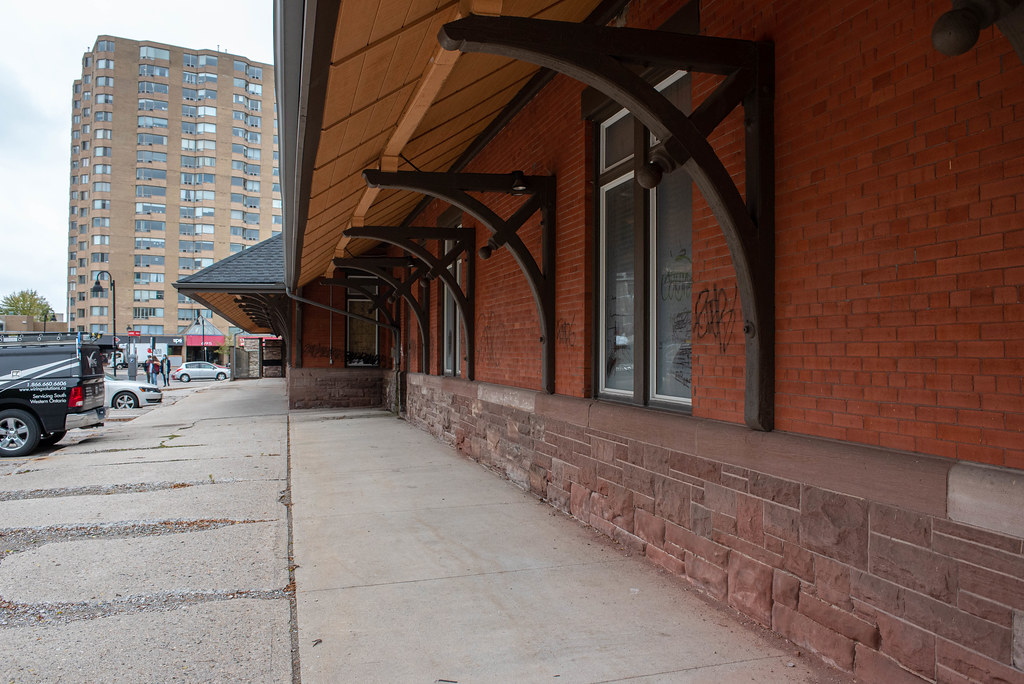Sitting north of the downtown, surrounded by tall towers and more restaurants than you can shake a stick at, the former London Richmond Street Station is far worse for wear out of all the stations I have visited throughout this project. While most stations I’ve featured are in good condition, well-maintained, and protected, none can be said for this one.

Graflex Crown Graphic – Fuji Fujinon-W 1:5.6/125 – Ilford HP5+ @ ASA-200 – Pyrocat-HD (1+1+100) 9:00 @ 20C
The first three railways to arrive in London came in the 1850s, with Great Western Railway driving their mainline through the small city with Grand Trunk coming in from St. Mary’s. And in 1856, London and Port Stanley arrived in the city. When the Credit Valley Railway began expanding from Streetsville to connect the Canadian Southern Line in St. Thomas, they ran south of the city. Hence, investors in London formed the London Junction Railway in 1882. Chartered initially to build a line from London to Port Burwell, before any work started, Credit Valley leased the entire line for 999 years beginning in 1883, ultimately ending up in the Canadian Pacific Railways pocket by 1884 through Ontario & Quebec Railway. Realising the opportunity, the West Ontario Pacific Railway chartered to build a line from the St. Clair River to Woodstock, which after an 1886 amendment, would run through London. The city planned to host the maintenance facilities for the West Ontario Pacific and the main station. The yards would fill in between Quebec and Adelaide, with a small passenger station on Richmond. Sadly there is no surviving description of this early station. The line opened in 1887, and a year later, the entire board was replaced with members friendly to Ontario & Quebec and the Canadian Pacific, ensuring complete domination.

Nikon D750 – AF-S Nikkor 28-70mm 1:2.8D

Nikon D750 – AF-S Nikkor 28-70mm 1:2.8D
London provided a central location for Canadian Pacific’s London division; the yards quickly expanded west, right out to Richmond Street, where the small station was. Canadian Pacific constructed several maintenance buildings at the central yards, including a large roundhouse. But they lacked appropriate office space for their divisional offices. The old station went down, and a new Maxwell-style station went up. A simple low one-storey station with limestone foundations and dark brown brick. A shallow peaked roof with wide eves. Inside were a general waiting area and a separate lady’s parlour with hardwood floors, wainscoting, plaster walls and ceilings. A station agent’s office, ticket window and baggage room rounded out the rest of the station. The first train ran through the station in 1893. Canadian Pacific also included several large freight sheds and cattle pens nearby to further support the region’s agricultural economy. The divisional offices would come later in 1906, a two-storey addition added to the eastern side of the station. The first floor housed the express office. The second floor contained the divisional offices, which were then extended across the original building using a Tutor Revival style for the second floor. The entire station proved popular among those in London; its proximity to the downtown gave people a choice on which railway to use. By 1926, a lunch counter was added in a separate building to entice people further. Throughout the station’s service, there were only minor. The exterior remained untouched while the interior received a few modifications. A drop ceiling was added, and modern lighting and the two waiting areas were combined throughout the second half of the twentieth century. By 1971 passenger service at the station was discontinued, and most of the exterior buildings were demolished. Only the presence of the divisional offices kept the station standing. But even these were starting to become redundant; by 1989, Canadian Pacific had moved into a new building in the yard.

Nikon D750 – AF-S Nikkor 28-70mm 1:2.8D

Nikon D750 – AF-S Nikkor 28-70mm 1:2.8D
Surprisingly the station never received any indication of being granted a historical designation. Instead, Canadian Pacific sold it off to private interests. The area known as Richmond Row had taken on a bit of a seedy reputation by the 1990s, and the old station became a pub and pool hall known as the Shot Pool Pub, which opened in 1995. The business tore out the interior and stripped it of any historical items and decor. The Shot Pool did not last long, transforming into a dance club, the Shot & Base, a two-storey club offering two different dance styles through the balance of the 1990s. As the area improved its reputation, new and classier restaurants began to open along with Richmond, and the old station fell into new ownership. In 2002 they dumped a fourteen million dollar renovation effort into the station, which did nothing to restore the interior but clean up the exterior. It reopened the same year as a Keg Steakhouse & Bar franchise. While many such ventures along Richmond enjoyed relative success, the biggest issue remained to park. The city-owned lots were managed by third parties, meaning the customers had to pay. While some survived, by 2016, the Keg at the old station closed and relocated to a better property. Since then, the station has sat empty. When I visited in October 2021, there were signs of work being done on the interior. I could see construction lights, but I could also see a lot of vandalism and broken windows. And with no sign of an end goal, I do not have high hopes for the old station’s survival.

Nikon D750 – AF-S Nikkor 28-70mm 1:2.8D